Parrots feathering can boast various color patterns. Still, one of the rarest and eye-catching is the red color. Rarely you’ll find a parrot that is all red. But there are numerous parrots with red feathering combined with other colors such as green, orange, yellow and blue.
Scarlet macaws, green, and red macaws are parrot species with red color patterns. Other red parrots are female Electus, a few kinds of a lorry, western rosella, and salmon-crested cockatoo.
The red color of feathers is guaranteed by specific pigments – psittacofulvine. At the same time melanin, adds to the uniqueness of color patterns when we speak about parrots feathering.
The colors of feathers help define various parrots’ species. Below you’ll find the most wide-spread red parrot with an explanation of their behavior, temperament, and other features.
What Makes Parrots Red?
Psittacofulvins is one of the pigments responsible for the presence of red color in parrot’s feathering. However, as per the Current Biology study, this pigment adds green, pink, and orange color patterns. These pigments appear inside feather follicles.
Such a mechanism stands out among other birds, which usually get their color patterns from pigments named carotenoids.
Melanins also make the parrot’s coloring red. Different concentration of this pigment in the natural black color patterns creates lighter colors.
Bright colors in parrots not only serve aesthetic purposes. This is a powerful surviving tool. With red colors in their feathers, parrots can:
- Be successful in mating. Bright colors indicate the healthier spice and suggest the parrot has better reproductive features. For example, male parrots compete with others using red-colored feathering to win a female during mating season.
- Communicate with other birds. Bright red feathering serves as a caution sign to predators and parrot’s enemies.
- Decide on the feeding of young parrots. Parrots’ chicks usually have brighter colors around their mouths. So based on such coloring, adult parrots can understand which chick still needs to be fed.
- Hide. To avoid predators, bright red feathers serve as camouflage =. So red parrots can hide among brightly-colored flowers and trees in the wild.
Red Parrot Species
Red plumage is always accompanied in parrots by other colors and tones. So you can hardly ever see a parrot that is totally red. But there are parrot species that bear red as one of the main in their feathering. These are:
Australian King Parrot
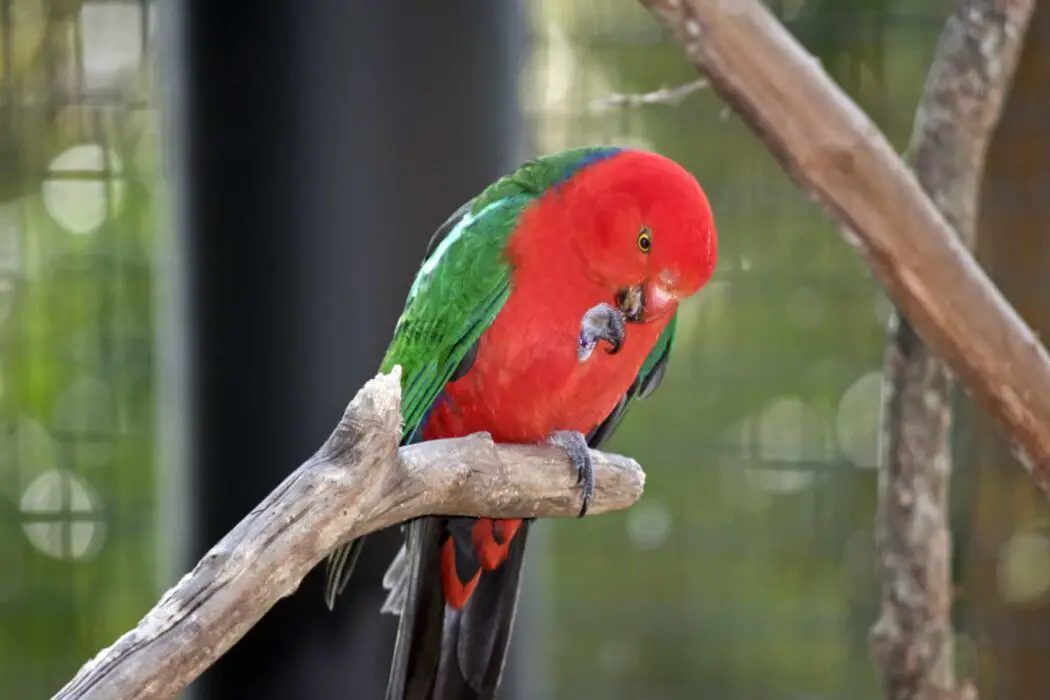
According to its name, the Australian king parrot originates from Australia. It’s rarely seen in the areas outside this country. Male parrots bear more red color on their plumage compared to females. Their bright green wings add vibrancy to the color pattern along with the purple back.
Females have got thighs and tummies of an orange hue. Their bodies are more of forest-green with light green chests. They have a mixture of green and red under their tails.
Because of such bright coloring Australian king parrots become popular as pets. They are pretty quiet and rarely scream. This makes them suitable for small apartments and homes.
They can mimic simple sounds, but don’t say words so they are not talking parrots.
Black-Winged Lory
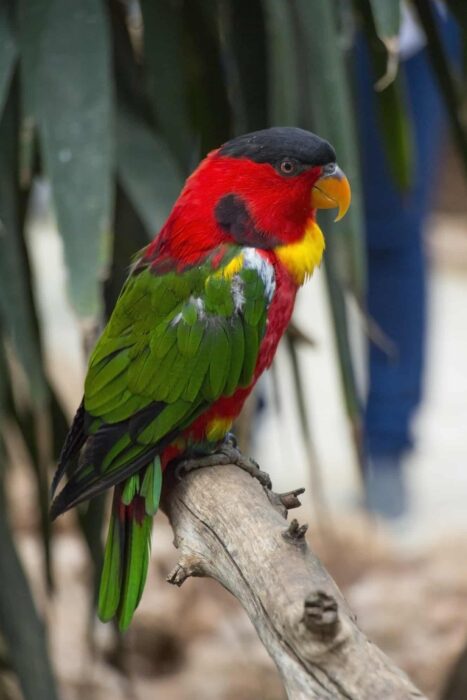
Otherwise called the blue-cheeked lory, dark-winged lories are dominatingly red with a sprinkle of violet around their eyes. They likewise have dark shoulder plumes and dark wing and tail tips.
Dark winged lories don’t just have red plumes; they additionally have red beaks. Most of them have brown or dark beaks, yet this is a somewhat interesting element. Their eyes are additionally red.
Tragically, dark-winged lories are endangered. Most of them living today are in reproducing projects to save their species. Their numbers are lessening because of deforestation, hunting, and the illicit pet exchange. In any case, these parrots are seldom found in captivity.
In any case, hardly any reproducing programs are accessible, as dark-winged lories are forceful and can kill their mates.
A Full List of Lovebird Types (With Photo and Video)
Cardinal Lory

Cardinal lories are seldom found as pets. They’re native to the islands of Papua New Guinea. Their habitat includes the Solomon and Bougainville islands, plus the Bismarck archipelago. They live in tree shades and live in backwoods and waterfront forests.
Cardinal lories have a straightforward plumage comprising of red quills in different shades all around the body.
The wings and back are marginally hazier, while the chest has light streaks through it. There are dark quills around their feet and beak, which contrast against the parrot’s shading, making it remarkable.
Cardinal lories aren’t excessively noisy, however, they’re not the calmest birds. Their normal calls are clear and piercing, however, they don’t sing constantly. Assuming you’re adequately fortunate to observe one to be in captivity, it should make a cordial pet that is brimming with character.
Chattering Lory
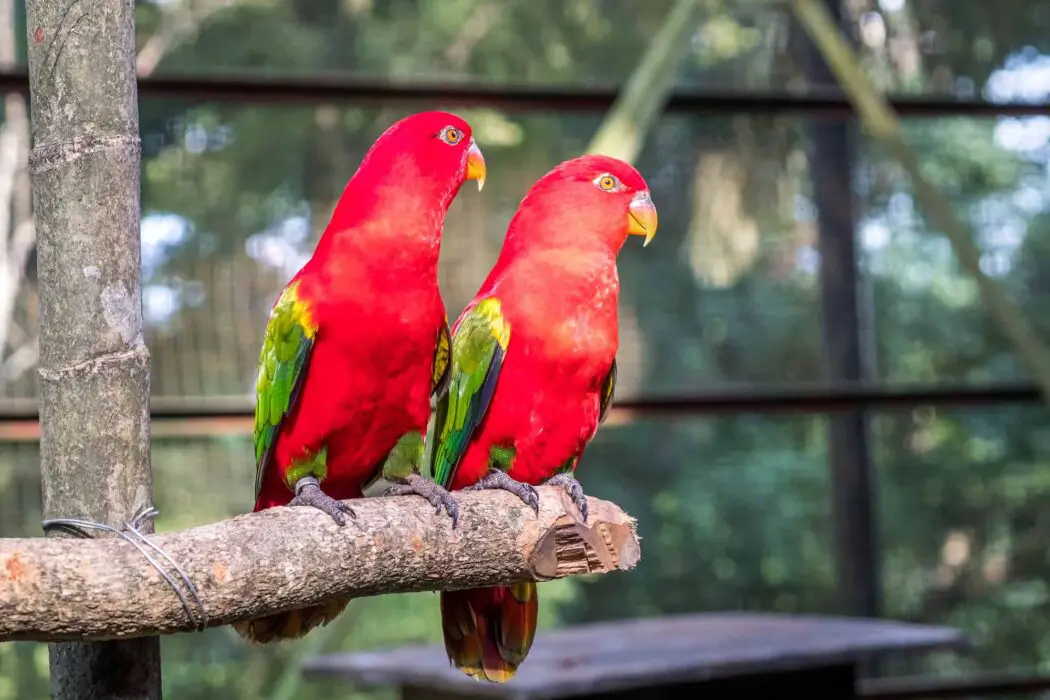
The chatting lory is from woods endemic to North Maluku, Indonesia. It has a prevalently red body and beak. Its eyes are orange. Its thighs and wings are green, while the wing coverts are yellow. Chatting lories additionally have a green tail with a blue tip.
The chatting lory is one more imperiled parrot animal varieties. Notwithstanding, it’s the most well-known kind of lory and is tenderly named on the grounds that it goes through the majority of the day babbling endlessly.
Prattling lories likewise have a noisy nasal whistle, which doesn’t sound wonderful to pay attention to. That is the reason they’re not fit to lofts.
Green Parrots 101 (With Photo and Video)
They can likewise impersonate family sounds and become loud toward the beginning of the day after dawn. A few proprietors find this irritating, however it’s their regular conduct, meaning it’s hard to stop.
Crimson Rosella
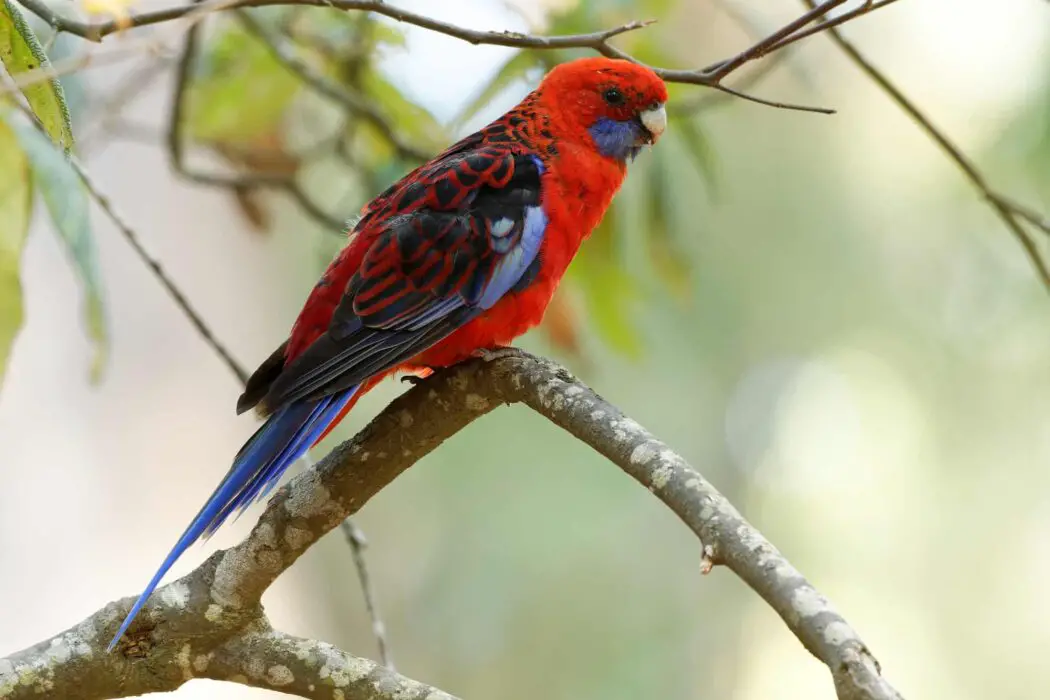
The red rosella is among most popular rosella pets. They’re cordial birds that truly do well with different birds inside an foul-run.
Male birds are generally radiant red with dazzling blue facial patches. They additionally have blue feathers on their tail and wings. Females are comparative, yet they have a dim green feather patches in the center of their tails.
If we compare them with other parrots, dark red rosellas aren’t cuddly and tender. They don’t like an excess attention and rather not be petted. Nonetheless, they in all actuality do jump at the chance to roost on their owners’ shoulders every once in a while. Watch out for their chomp, as they can be nippy, crotchety birds which is their typical conduct.
Female Eclectus
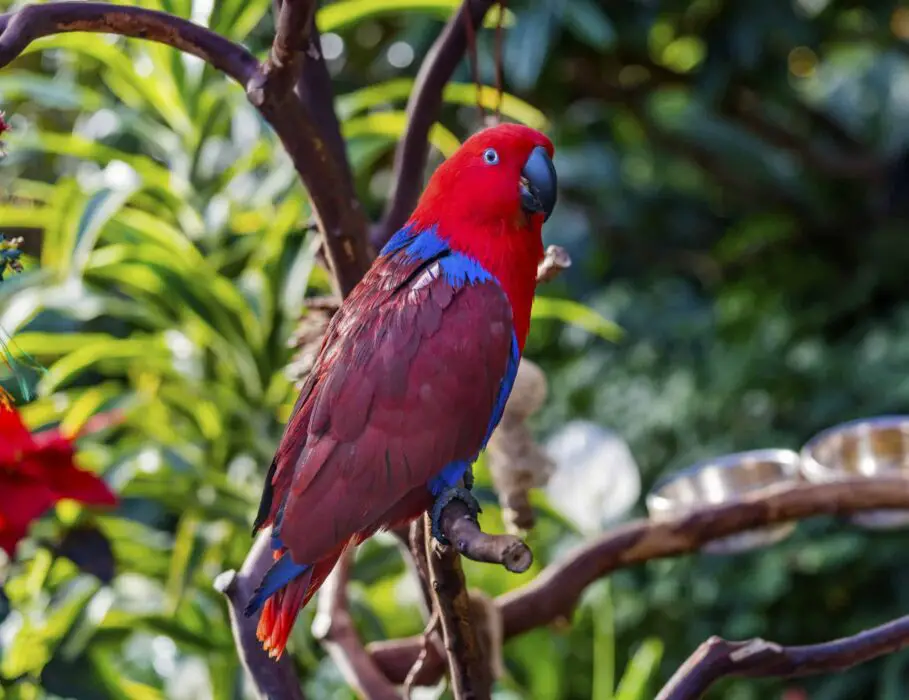
On the contrary to male parrots that wear stunning green feathering, females of this kind are sparkling red with blue feathers in the lower chest, back, hips and wings. Their underwings area includes purple and mauve blue edges.
Eclectus parrots have feather tufts that appear to be warm and fleecy. This is one explanation they’re such notable pet birds. They’re furthermore fun and oversee everything admirably with youths, making them phenomenal for families. They don’t see the value in unexpected commotions, so they’re the most suitable to more quiet homes.
How Long Do Eclectus Parrots Live? Simple Ways to Prolong Their Life
Regardless, since they’re large birds, Eclectus parrots need lots of space. They should be kept dynamic, so as long as they have tons of out-of-cage time and the greatest fenced-in area you can fit into your home, your bird will remain active and sound.
Galah Cockatoo
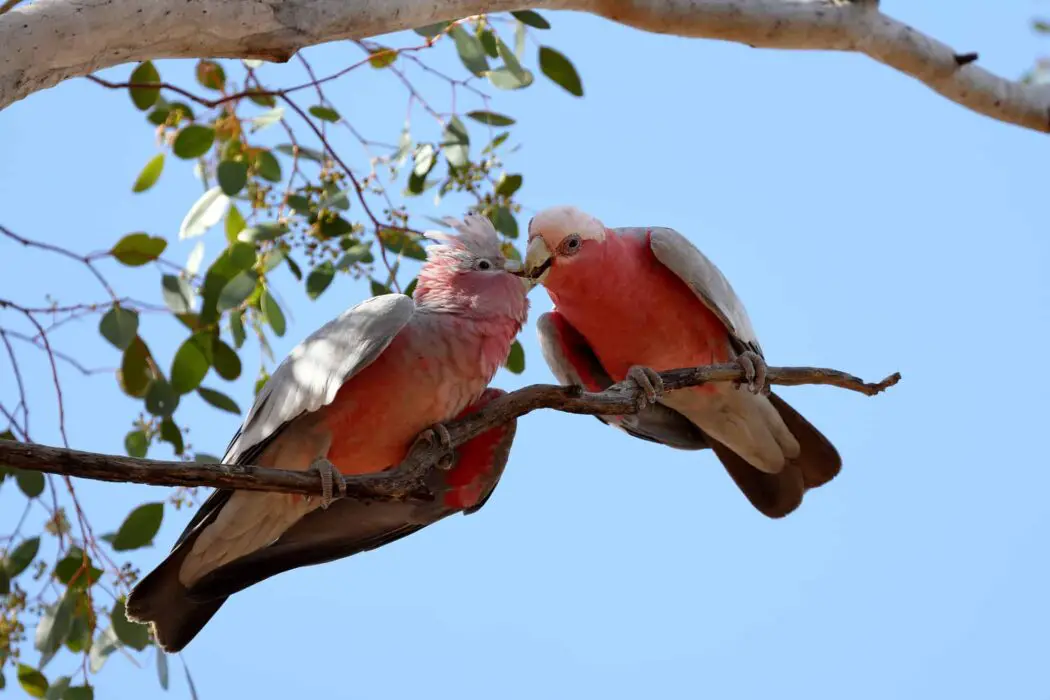
Also called the rose-breasted cockatoo, galahs are fundamentally pink, but a couple of parrots’ plumes are more similar to a light red. They wear pinkish-white pinnacles and dull wings, backs, feet, and tail feathers. Males and females look the same, yet male parrots have dull irises. On the contrary, females’ are light pink.
Galah cockatoos originate from Australia. These birds aren’t loud but they are vocal. They scream and yell when they’re frightened, fortified, or need attention. They can mimic voices and sounds that are repeated.
Galah cockatoos favor contributing whatever amount of energy into playing with their owners. They’re delicate and friendly, that’s why they get along well with various birds in the household. In case you don’t give yours the timeit needs, it can turn out to be depressed and angry. This suggests galahs require commitment.
A Full List of Cockatoo Types (With Photo and Video)
Moluccan King Parrot
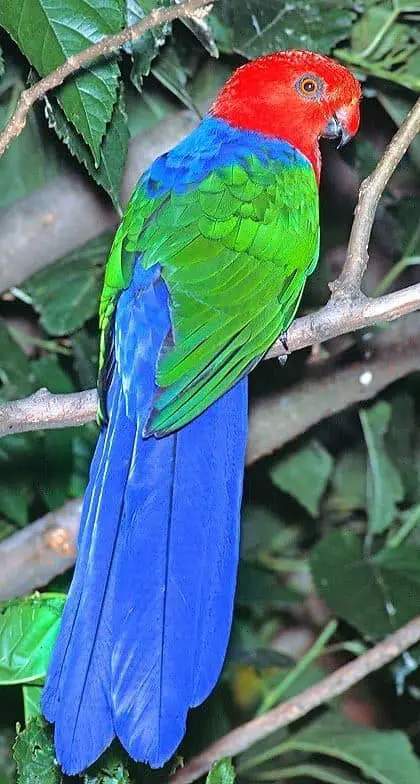
Moluccan king parrots are renowned for their obvious plumage. They have transcendently red plumes with dazzling green wings and a radiant blue back, backside, tail, and wing coverts. Male and females resemble the other the same, and the best way to recognize them is with a DNA test.
At just about 15 inches, Moluccan rulers are a medium-sized parrot animal categories. All things considered, they need a lot of room inside and outside of their enclosure.
Unfortunately, the Moluccan ruler parrot populace is decreasing because of predation and the deficiency of living space. That implies they’re generally intriguing in bondage. Be that as it may, they’re ideal pets as they’re tranquil and delicate. With the right consideration and consideration, they make solid bonds with their proprietors and appreciate investing energy with them.
Papuan King Parrot
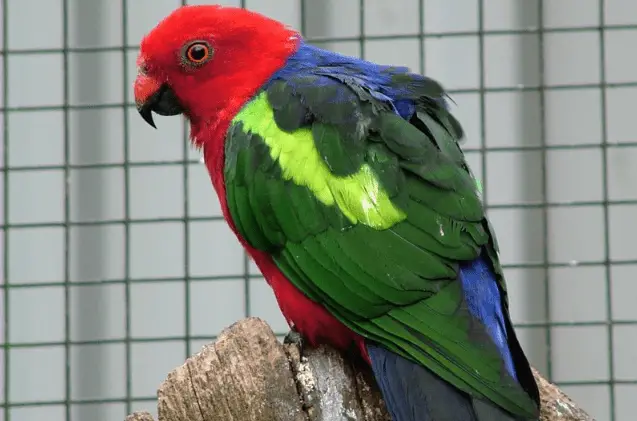
Otherwise called the green-winged king parrot, male Papuan lord parrots are totally red aside from their orange irises, blue back and backside, dazzling green wings, and dim dark legs. Females have a similar tinge, aside from their heads are green, and they have green and red striations on the chest.
Papuan ruler parrots are ideal beginner pets since they’re peaceful and resigned. They’re manageable birds, even in nature. That being said, they don’t really want to be taken care of time and again and partake in their own space.
Guarantee that a Papuan king parrot has a lot of room to fly and meander. Let it out of its enclosure routinely. Invest heaps of energy into your parrot, and it’ll stay blissful.
Purple-Naped Lory
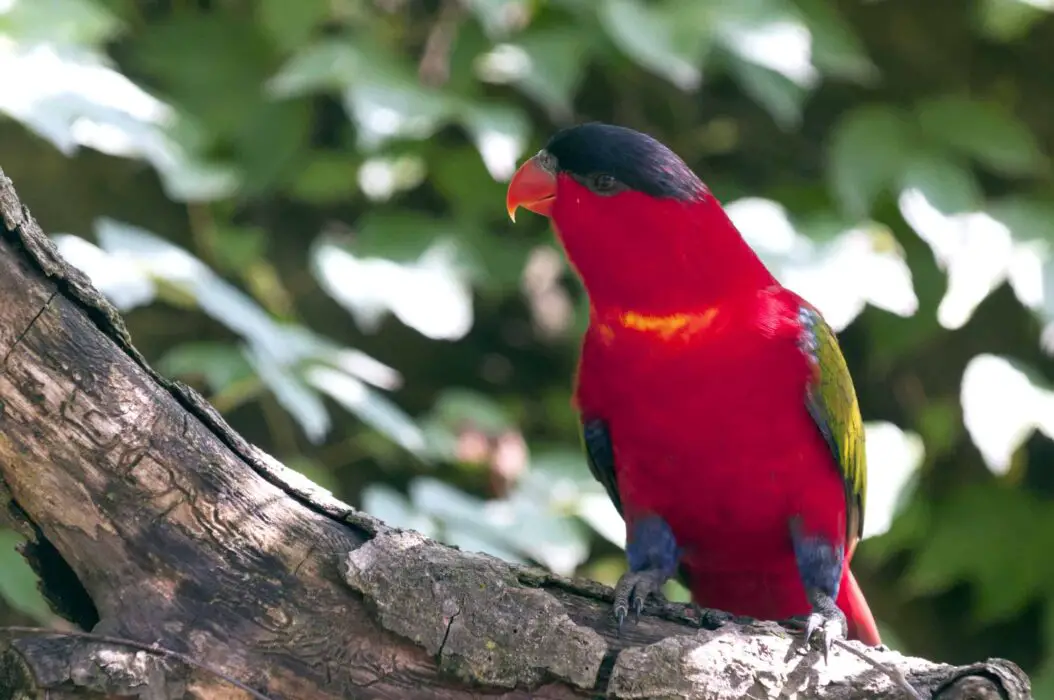
The purple-naped lory has a red body, dark forehead, and a yellow band on his breast. It has purple thighs, which can likewise present as blue in certain birds, green wings, and a yellow underwing band. The tail is red, yet it’s tipped with a more obscure burgundy tone. The eyes are either orange or red, while the eye rings are dull dim.
Purple-naped lories have become defenseless and are currently thought to be imperiled because of tenacious catching for the unlawful pet exchange. While you can think that they are in imprisonment, not all have been reared for the pet exchange and were once wild. This implies they make troublesome pets since they’re accustomed to having their opportunity.
Red and Blue Lory

Red and blue lories seem to be like purple-naped lories, however, they’re bluer. They possess a solitary island in the Indonesian archipelago called Karakelang. They’re physically monomorphic, meaning males and females are tastefully similar.
The plumage, wings, back of the head, and quills around the nostrils are dazzling red. The red and lower tummy are additionally red yet are somewhat more obscure. The scruff of the neck and back is a lively violet tone, while the bosom includes a dark blue band.
Red and blue lories are seldom found in the pet exchange, and because of their declining numbers, all global exchange of the birds is precluded. Unfortunately, they’re actually caught and gotten for the illicit pet exchange. They utilize short, babbling vocalizations to speak with one another.
Red and Green Macaw
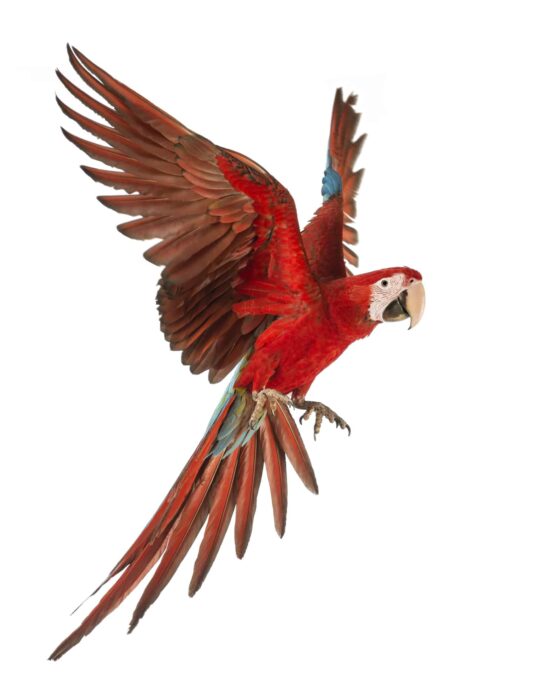
called the green-winged macaw, red and green macaws are another renowned red parrot species. While they’re like red macaws, they can be recognized by their multicolored blue and green wings.
Red and green macaws have red lines around their eyes, which appear differently in relation to their uncovered white skin. This is probably the simplest method for recognizing red and red and green macaws. They’re likewise bigger and are, indeed, the second-biggest parrot species on the planet.
A Full List of Macaw Types (With Photo and Video)
While red and green macaws are famous birds, they don’t make ideal pets. They need a similar consideration as a little youngster and have strong beaks, meaning they can ruin family things.
Red Lory
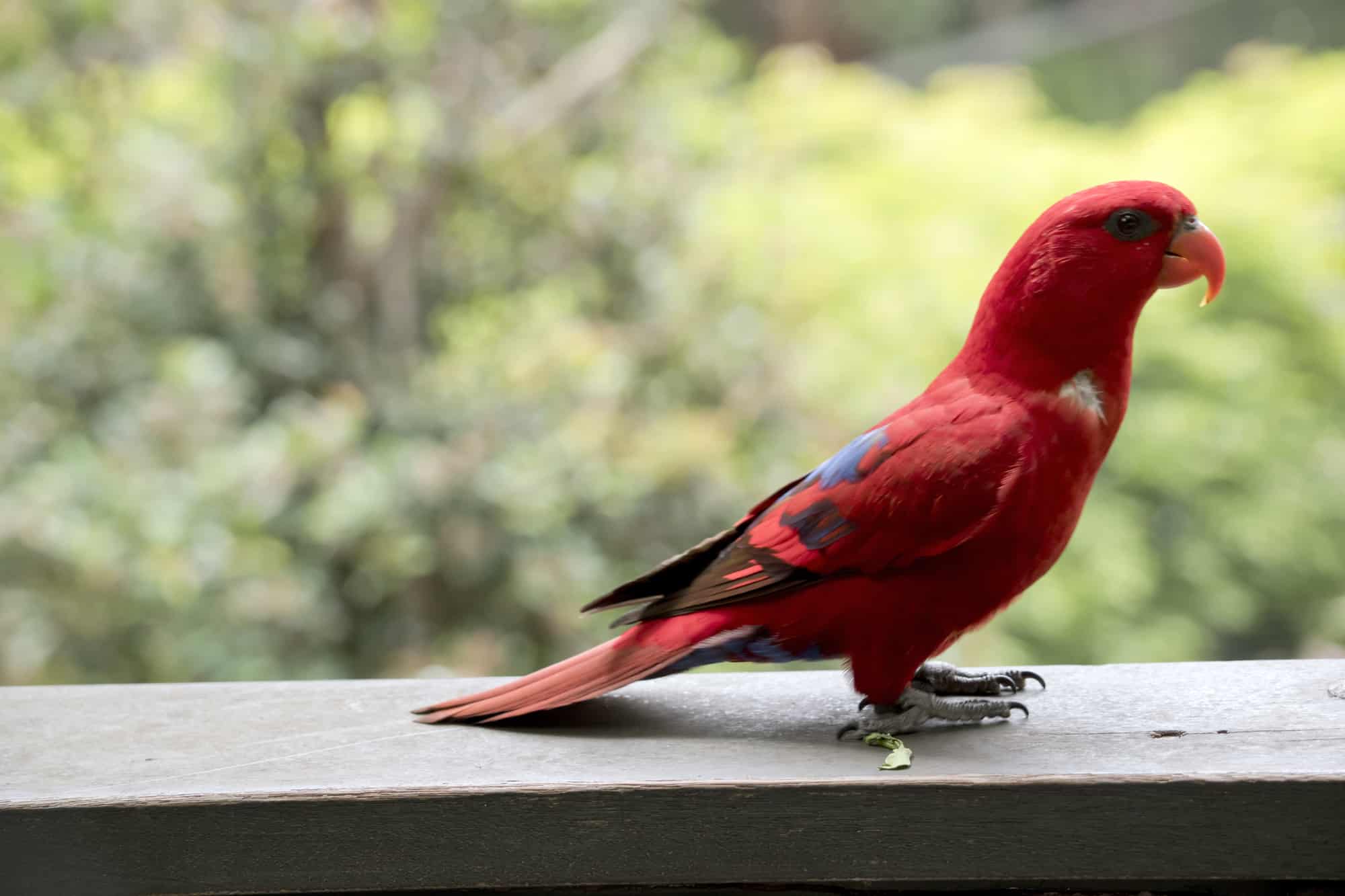
Red lories are comparable in shape and size to red and blue lories. Their bodies are essentially red, with the exception of blue and dark markings on the back and wings. The tail is additionally earthy red with blue under tail coverts. They have brown-red eyes and orange-red mouths.
Red lories are profoundly engaging birds. They appreciate prattling away to their proprietors and require a lot of social collaboration. Despite the fact that they’re somewhat little, they need loads of regard for keeping them from getting exhausted. They can likewise become nippy and horrendous around the home, so they need consistent management.
After the rainbow lorikeet, red lories are the most ordinarily kept lory species in imprisonment. That is on the grounds that their proprietors love their showy and dramatic characters, which keeps them engaged for quite a long time.
Salmon-Crested Cockatoo
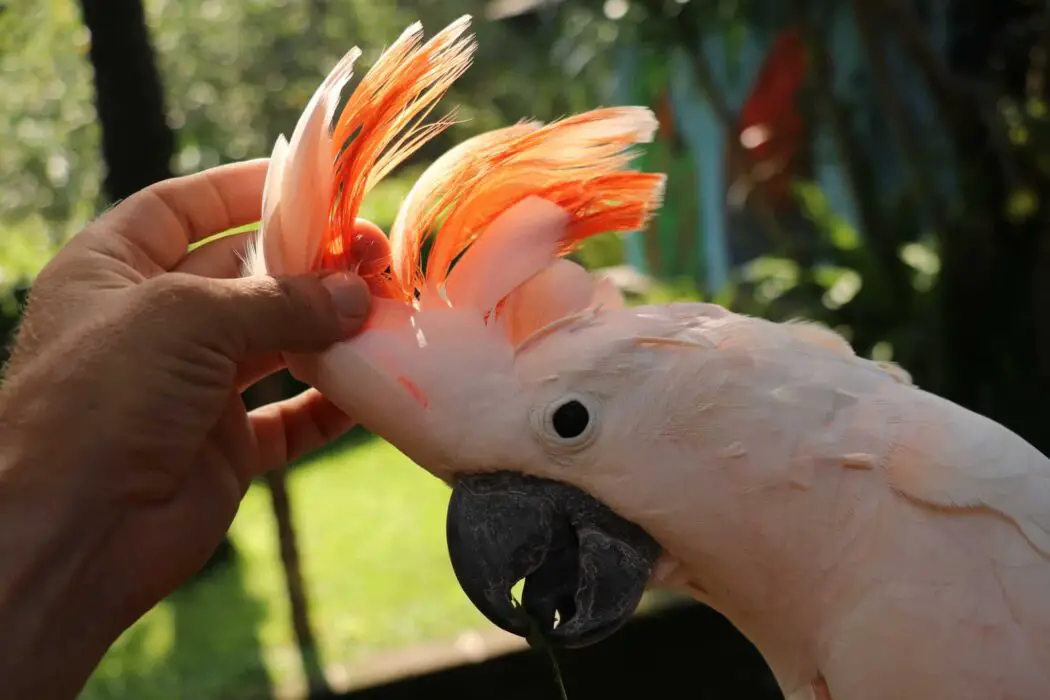
The salmon-peaked cockatoo is otherwise called the Moluccan cockatoo, which is not the same as the Moluccan lord. It’s well known for its ruddy pink plumes, with are feathery and fluffy. These parrots additionally have a peak that seems at whatever point they’re energized, furious, or apprehensive.
Salmon-peaked cockatoos are uncommon in the wild, yet they’re not difficult to get hold of in bondage because of a few effective rearing projects. They need heaps of room inside and outside their enclosure and appreciate investing a lot of valuable energy with their proprietors.
How Much Should You Pay for a Cockatoo?
If you don’t watch out, they can turn out to be very destitute and ordinarily become desirous one-individual birds. However, the right preparation and socialization from early on should assist with keeping these practices from turning into an issue. You can likewise encourage your bird to perform deceives and hits the dance floor with time and persistence.
Scarlet Macaw
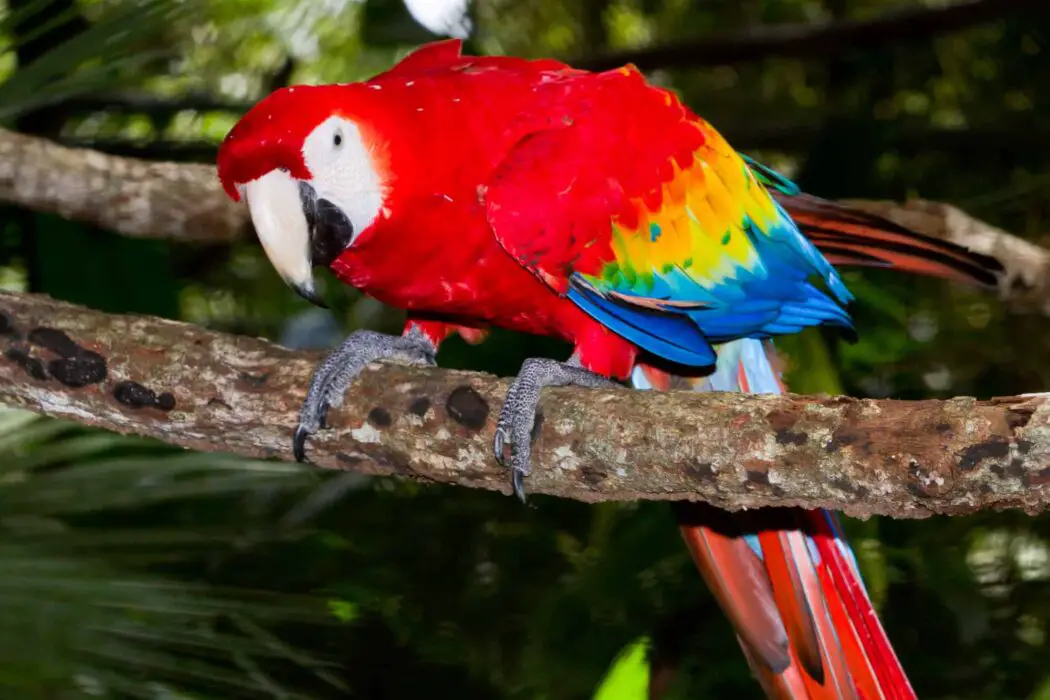
Red macaws are one of the most unmistakable parrot species on the planet. Their plumage is transcendently radiant red, yet they likewise have a light blue rear end and tail feathers, hazier blue quills on the last part and wings, and yellow quills on the upper wings. A few red macaws additionally have a gold color on their tail flight feathers.
Red macaws have comparable plumage to green-winged macaws and are comparative in size, so they’re ordinarily confused with them. Yet, at 32 inches long, red macaws are somewhat more modest.
Are Macaws the Smartest Parrots?
Wild red macaws are frequently tracked down licking the dirt off the goliath dividers of the Peruvian salt licks. They show up in huge red rushes, making a glorious sight anybody cruising by.
Violet-Necked Lory
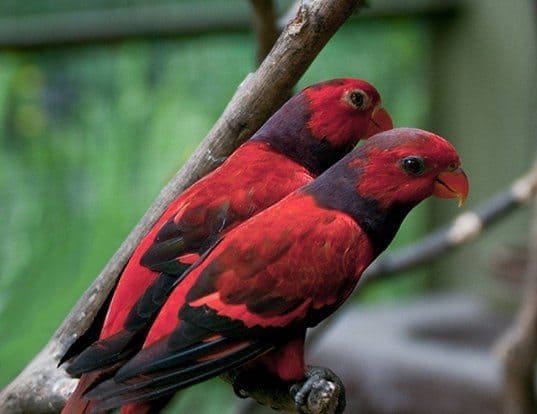
Violet-necked lories look similar to female Eclectus parrots, yet they have orange noses. The plumage is principally red with enormous violet groups around the head and chest. The amount of a common each parrot has relies upon the subspecies, which comprises of:
- E.s Squamata
- E.s Riciniata
- E.s Obiensis
They additionally have red and dark wings and a purple-red tail. Out of all the lory parrots, violet-necked lories are viewed as the most delicate. They’re social birds that appreciate investing energy with their proprietors.
They additionally spend a lot of their time copying fundamental words and sounds. In any case, their jargon isn’t quite as broad as a few different birds. They’re not excessively clear or loud, so they’re reasonable for condos or little houses.
Western Rosella
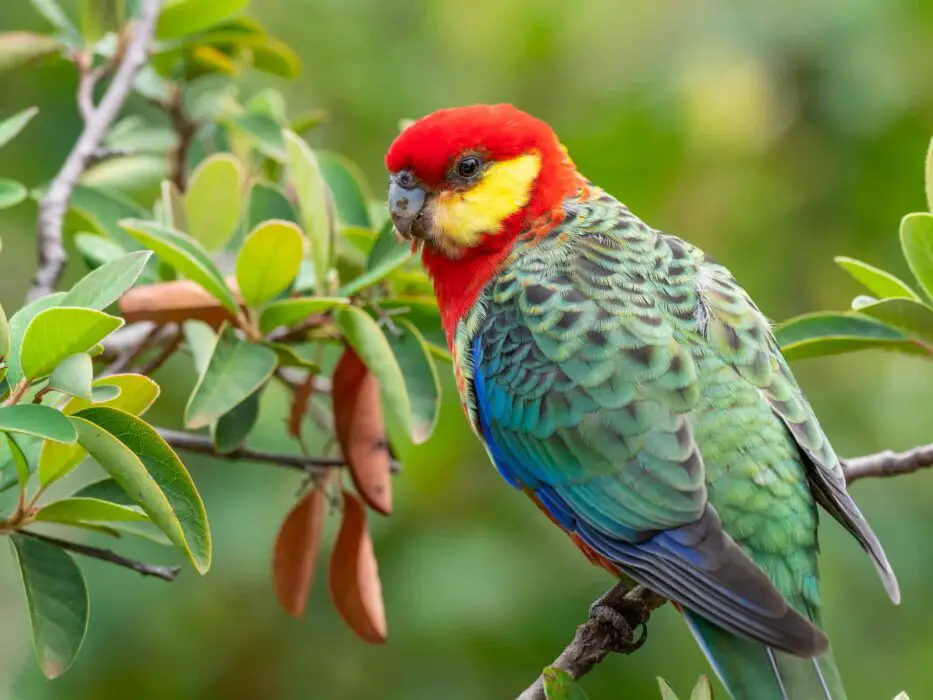
Western rosellas are the just rosella parrots found in southwestern Australia. The head and the underside of the parrot’s plumage are red, while the back is mottled dark. Western rosellas additionally have dazzling yellow cheeks, which recognizes them from other rosellas.
They are somewhat blunter than males and the greater part of the red quills around the head, neck, and underparts are green.
As pets, western rosellas have melodic vocalizations that are wonderful to pay attention to. They’re peaceful birds, however, they truly do utter continuous sounds. They now and then additionally whistle, which can be irritating to local neighbors.
They hide, particularly when eating, yet they seem undisturbed by people and wouldn’t fret guests drawing near to them.
How Long Do Red Parrots Live?
The answer to the question of how long will your red parrot live is defined by the parrots’ species. Usually, tiny parrots have a shorter lifespan. Bigger types of parrots can live as long as an average person. This makes having a parrot a commitment for your whole life.
How Long Does Your Parrot Live?
So before you pick the parrot, consider how many years of your life you are ready to dedicate to this bird. Also, in cases with long-living parrots, will you be able to organize someone to take over the ownership if anything happens to you?
The below table shows the average lifespan of red parrots species:
|
Red Parrot Species |
Average Lifespan (Years) |
|
Australian King Parrot |
25 – 30 |
|
Black-Winged Lory |
25 – 35 |
|
Blue-Eared Lory |
15 – 32 |
|
Blue-Streaked Lory |
15 – 32 |
|
Cardinal Lory |
28 – 32 |
|
Chattering Lory |
20 – 30 |
|
Crimson Rosella |
20 – 30 |
|
Crimson Shining Parrot |
Unknown |
|
Female Eclectus |
30 – 50 |
|
Galah Cockatoo |
40 – 70 |
|
Moluccan King Parrot |
30 – 40 |
|
Papuan King Parrot |
15 – 25 |
|
Purple-Naped Lory |
25 – 30 |
|
Red and Blue Lory |
10 – 15 |
|
Red and Green Macaw |
50 – 80 |
|
Red Lory |
30 |
|
Salmon-Crested Cockatoo |
Up to 70 |
|
Scarlet Macaw |
40 – 50 |
|
Violet-Necked Lory |
15 |
|
Western Rosella |
15 – 20 |
How Much Are Red Parrots?
The cost of various parrot types differs because these parrots belong to different families.
Their shape, size, and features are different. Traditionally, parrots types with a bigger lifespan cost more than others.
Older parrots cost more because they were already trained and they know how to socialize with the owner. If a parrot can talk it makes him more attractive to the buyer. However, getting a younger bird may be more attractive because you have more chances to create a stronger bond with the pet.
What Talking Parrots Are the Cheapest?
There are some parameters that define the cost of the parrot:
- Age
- Gender
- Genetics
- Lifespan
- The reputation of its breeder
- Birds personality and temperament
- Diseases
- Bird’s ability to talk
- Unique features
- Colors
We’ve gathered some average parrot costs below:
|
Red Parrot Species |
Average Price (USD) |
|
Australian King Parrot |
$100 – $500 in Australia, $1000+ in the US |
|
Black-Winged Lory |
N/A – Endangered |
|
Blue-Eared Lory |
N/A – Endangered |
|
Blue-Streaked Lory |
$300 – $400 |
|
Cardinal Lory |
$400 – $500 |
|
Chattering Lory |
$300 – $400 |
|
Crimson Rosella |
$300 – $500 |
|
Crimson Shining Parrot |
N/A – Endangered |
|
Female Eclectus |
$1,000 – $3,000 |
|
Galah Cockatoo |
$700 – $3,000 |
|
Moluccan King Parrot |
$300 – $600 |
|
Papuan King Parrot |
N/A |
|
Purple-Naped Lory |
N/A – Endangered |
|
Red and Blue Lory |
$200 – $300 |
|
Red and Green Macaw |
$3,000 – $4,000 |
|
Red Lory |
N/A |
|
Salmon-Crested Cockatoo |
$3,000 – $4,000 |
|
Scarlet Macaw |
$2,000 – $4,000 |
|
Violet-Necked Lory |
$300 – $400 |
|
Western Rosella |
$300 – $600 |


